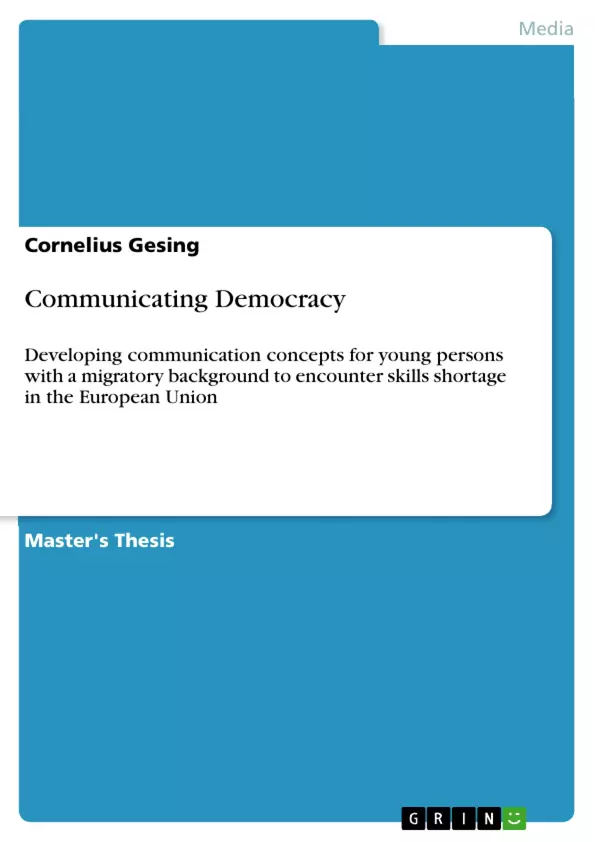In order to address the polycrisis the European Union is currently facing, the European Commission has proposed to declare 2023 as the European Year of Skills and thus actively combat one of the major crises: the skills shortage. This year, an ambitious agenda is being pursued to find lasting solutions, which aim to address this pressing crisis. A key approach of the comprehensive program of the European Commission is to integrate persons with a migratory background into European society. New concepts and campaigns including enhanced learning opportunities, attractive offers around improved mobility and support, and simplified recognition of foreign qualifications are a promised way to facilitate the integration of people from third countries with urgently needed competencies and skills. However, a strategic communicative process is needed to ensure that persons with a migratory background are genuinely understood as well as see themselves as part of European society. Therefore, this research paper picks out the uncovering of motives for migrating to the European Union and needs of persons with a migratory background as a central theme in order to address this certain group effectively. Since the youth play a central role in the shortage of skilled workers and in securing collective prosperity, only young people in the age of 15 to 25 were interviewed for that reason. At the end of the paper, recommendations for communication concepts will be identified that help to create synergies and close the gap between persons with a migratory background and the skills shortage crisis.
Inhaltsverzeichnis (Table of Contents)
- Introduction
- Theoretical Background
- The EU and its Crises
- Skills shortage and the EYS2023
- Migration as a chance
- Communication approaches
- Research questions
- Methodology of the research
- Research design
- Interview guide and process
- Sample group
- Transcription formalia
- Interview evaluation
- Quality insurance
- Data analysis
- Motives
- Needs
- Image of the European Union
- Visual Language of Migration
- Discussion and results of the findings
- Demographic Data and Locality
- Motives and Needs
- Visual Language
- Communication Approach
- Explore Your Way in Europe
- Study in the European Union & Paths in Europe
- Protected by the European Union & Just Arrived in Europe?
- Stronger Together
- 2 Passports - Your EU!
- Communication Channels
- Evaluation and Budget
- Recommendations for further Research
- Conclusion
Zielsetzung und Themenschwerpunkte (Objectives and Key Themes)
This paper aims to develop communication concepts and identify recommendations for communication departments that are tailored to the motives and needs of young persons with a migratory background to combat skills shortage during EYS2023. To achieve this, the study will:- Examine the motives and needs of young persons with a migratory background who come to Germany, specifically Hamburg.
- Analyze how these individual motives connect to the model of Desmet and Fokkinga.
- Translate this knowledge into symbols and create effective communication content to fight skills shortage in EYS2023.
Zusammenfassung der Kapitel (Chapter Summaries)
- Introduction: This chapter sets the stage for the thesis by outlining the EU's current polycrisis and the shortage of skilled workers as a central crisis. It discusses the potential of migration as a solution to the crisis and emphasizes the importance of communication strategies tailored to the specific needs of young persons with a migratory background.
- Theoretical Background: This chapter provides the theoretical foundation for the research, exploring the EU's polycrisis, the skills shortage, migration as a chance, and the importance of communication approaches. It also outlines the research questions driving the study.
- Methodology of the research: This chapter describes the qualitative and explorative research design, including the development of the interview guide, the characteristics of the sample group, and the transcription and evaluation methods used.
- Data analysis: This chapter presents the analysis of the interview data, focusing on the motives and needs of the participants, their perceptions of the EU, and the visual language they used to express their experiences.
- Discussion and results of the findings: This chapter connects the theoretical framework with the data analysis, highlighting the importance of demographic data, locality, motives, needs, visual language, communication channels, evaluation and budget in designing communication content.
- Recommendations for further Research: This chapter outlines limitations of the present work and identifies potential avenues for future research, including the need for a larger sample size, diverse research team, and further validation of the findings.
Schlüsselwörter (Keywords)
This research explores the need for strategic communication with young persons with a migratory background in the context of the European Union's skills shortage crisis. It focuses on communication strategies, the European Union, the skills shortage, migration, crises, and the concept of the polycrisis.- Citation du texte
- Cornelius Gesing (Auteur), 2023, Communicating Democracy, Munich, GRIN Verlag, https://www.grin.com/document/1390834



